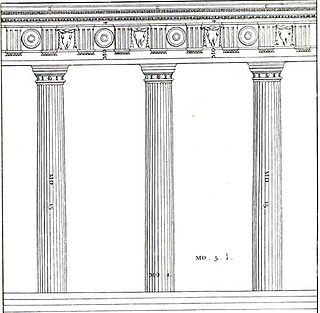Intercolumniation

Illustration from The Four Books of Architecture by Andrea Palladio, translation by Thomas Ware published in London, 1738
In architecture, intercolumniation is the spacing between columns in a colonnade, as measured at the bottom of their shafts.[1] In classical, Renaissance, and Baroque architecture, intercolumniation was determined by a system devised by the first-century BC Roman architect Vitruvius.[2] Vitruvius compiled standard intercolumniations for the three classical Greek orders, expressed in terms of the column diameter,[1] twice the Vitruvian module, and he warned that when columns are placed three column-diameters or more apart, stone architraves break.[3]
Standard intercolumniations
The standard intercolumniations are:[4]
- Pycnostyle
- One and a half diameters
- Systyle
- Two diameters
- Eustyle
- Two and a quarter diameters (and three diameters between middle columns front and rear); considered by Vitruvius to be the best proportion[5]
- Diastyle
- Three diameters
- Araeostyle
- Four or more diameters, requiring a wooden architrave rather than one of stone
- Araeosystyle
- Alternating araeostyle and systyle
See also
- List of architecture topics
- Architectural glossary
References
^ ab "Intercolumniation". The Columbia Encyclopedia, sixth edition. Columbia University Press. Retrieved 2007-06-03..mw-parser-output cite.citation{font-style:inherit}.mw-parser-output q{quotes:"""""""'""'"}.mw-parser-output code.cs1-code{color:inherit;background:inherit;border:inherit;padding:inherit}.mw-parser-output .cs1-lock-free a{background:url("//upload.wikimedia.org/wikipedia/commons/thumb/6/65/Lock-green.svg/9px-Lock-green.svg.png")no-repeat;background-position:right .1em center}.mw-parser-output .cs1-lock-limited a,.mw-parser-output .cs1-lock-registration a{background:url("//upload.wikimedia.org/wikipedia/commons/thumb/d/d6/Lock-gray-alt-2.svg/9px-Lock-gray-alt-2.svg.png")no-repeat;background-position:right .1em center}.mw-parser-output .cs1-lock-subscription a{background:url("//upload.wikimedia.org/wikipedia/commons/thumb/a/aa/Lock-red-alt-2.svg/9px-Lock-red-alt-2.svg.png")no-repeat;background-position:right .1em center}.mw-parser-output .cs1-subscription,.mw-parser-output .cs1-registration{color:#555}.mw-parser-output .cs1-subscription span,.mw-parser-output .cs1-registration span{border-bottom:1px dotted;cursor:help}.mw-parser-output .cs1-hidden-error{display:none;font-size:100%}.mw-parser-output .cs1-visible-error{font-size:100%}.mw-parser-output .cs1-subscription,.mw-parser-output .cs1-registration,.mw-parser-output .cs1-format{font-size:95%}.mw-parser-output .cs1-kern-left,.mw-parser-output .cs1-kern-wl-left{padding-left:0.2em}.mw-parser-output .cs1-kern-right,.mw-parser-output .cs1-kern-wl-right{padding-right:0.2em}
^ "Intercolumniation". Encyclopædia Britannica. Encyclopædia Britannica Online. Retrieved 2007-06-03.
^ Vitruvius, De architectura iii.3.4
^
"Intercolumniation". Webster's Dictionary, 1913. Retrieved 2007-06-03.
^ Vitruvius, De architectura, iii.3.6.
This architectural element–related article is a stub. You can help Wikipedia by expanding it. |